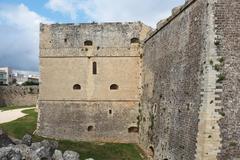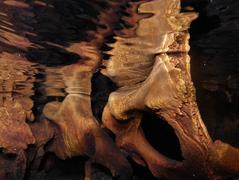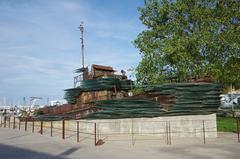Otranto Cathedral: Visiting Hours, Tickets, and Historical Sites in Otranto
Date: 15/06/2025
Introduction
Otranto Cathedral, officially known as the Cattedrale di Santa Maria Annunziata, is a remarkable landmark at the heart of Otranto, Italy. Its centuries-old history, architectural grandeur, and profound spiritual significance make it a must-visit destination for travelers seeking to explore the rich cultural and religious heritage of southern Italy. Founded in 1068 atop ancient Christian and Roman remains, the cathedral represents a unique blend of Puglian Romanesque, Byzantine, and early Christian styles. One of its most distinctive features is the extraordinary 12th-century mosaic floor, a masterpiece of medieval artistry and symbolism (Podere Santa Chiara; Puglialy; Lonely Planet; Italy Heaven).
The cathedral is also a living memorial to the 800 Martyrs of Otranto, who were executed in 1480 for refusing to renounce their faith during the Ottoman siege. Their remains are preserved in the Chapel of the Martyrs, making the cathedral both a place of pilgrimage and a symbol of resilience (Italian Notes; Trip101).
This guide provides comprehensive, up-to-date information on Otranto Cathedral’s visiting hours, ticketing, accessibility, guided tours, and the historical highlights you should not miss.
Historical and Architectural Overview
Origins and Construction
Otranto Cathedral was established in 1068 by Norman bishop William, built atop earlier Christian and Roman structures. Consecrated in 1088, the cathedral’s layout features three naves divided by twelve arches resting on fourteen monolithic granite and marble columns. Its semicircular apse and crypt, supported by repurposed ancient columns, reflect a harmonious fusion of Romanesque, Byzantine, and early Christian influences (Podere Santa Chiara; Puglialy; Flashpacking Italy).
Architectural Highlights
The Mosaic Floor: Pantaleone’s Masterpiece
The cathedral’s most celebrated feature is the vast mosaic floor, created by the monk Pantaleone between 1163 and 1165. Spanning the nave and aisles, it depicts the “Tree of Life” surrounded by biblical stories, classical myths, and medieval legends—a visual encyclopedia of medieval cosmology (Lonely Planet).
The Crypt
Beneath the presbytery lies the evocative 11th-century crypt, structured with over seventy uniquely styled columns and three apses. The crypt preserves fragments of frescoes from the Middle Ages to the 16th century, offering a rare glimpse into evolving regional artistry.
The Façade, Rose Window, and Bell Tower
The west façade, restored after the Ottoman siege, features a distinctive hut-shaped form and a remarkable rose window with sixteen rays, filtering sunlight into the nave. The Baroque portal from 1674 and the adjacent robust 12th-century bell tower add to the cathedral’s striking external profile.
Interior Decoration
Inside, the cathedral’s atmosphere is enriched by Byzantine-style frescoes, six altars dedicated to key Christian events and saints, an 18th-century silver antependium at the high altar, and a Baroque wooden coffered ceiling added in 1698.
The Martyrs of Otranto and the Chapel of the Martyrs
The 1480 Ottoman siege was a defining event in Otranto’s history. After a brutal siege, Ottoman forces executed approximately 800 townspeople who refused to convert to Islam. The relics of these martyrs are enshrined in the Chapel of the Martyrs at the end of the right aisle. Their bones are displayed in glassed recesses, and the “Martyrdom Rock” is preserved behind the altar (Italian Notes; Trip101; agriturismoilmegalite.it). This site is a focal point for pilgrims, especially since the canonization of the martyrs by Pope Francis in 2013.
Visiting Otranto Cathedral: Hours, Tickets, and Accessibility
Opening Hours (as of June 2025)
- June–August: 8:00–12:00 and 15:00–19:45
- September: 8:00–12:00 and 15:00–19:00
- October: 8:00–12:00 and 15:00–18:30
- February: 8:00–12:00 and 15:00–18:00
Hours may vary on religious holidays or for special events. Always check the official website before your visit.
Tickets and Admission
- General Admission: Free for all visitors (Trek Zone).
- Donations: Voluntary contributions are welcome to support ongoing preservation, particularly for the mosaic floor.
- Guided Tours and Museum: Access to the crypt, Diocesan Museum, and guided tours may require a ticket (€3–€7, with discounts for students, seniors, and groups).
Accessibility
- Wheelchair access is available at the main entrance; some areas, like the crypt, may have limited access due to historic constraints.
- Ramps and assistance services can be arranged by contacting the cathedral in advance (Mosaico di Otranto).
Guided Tours and Special Events
Guided tours are available daily in multiple languages. These offer expert insights into the cathedral’s art, history, and mosaic floor. Bookings can be made online or on-site. Special events, including concerts and religious celebrations, are held throughout the year—check the official site for updates.
Practical Tips for Visitors
- Dress Code: Modest attire (shoulders and knees covered) and hats removed inside.
- Conduct: Maintain silence and respect during services; eating and drinking are not allowed inside.
- Photography: Non-flash photography is permitted except during services or in restricted areas.
- Best Times to Visit: Early morning or late afternoon for fewer crowds and optimal lighting.
- Facilities: Restrooms are available; children are welcome if supervised.
Getting There and Nearby Attractions
Location
- Address: Piazza Basilica, 1 - 73028 Otranto LE, Italy (Mosaico di Otranto)
- By Air: Closest airports: Brindisi (100 km), Bari (200 km) (Italien Entdecken).
- By Train: Served by Ferrovie Sud Est from Maglie; short walk to the old town (Italy Heaven).
- By Car: Parking available outside the pedestrianized center; restrictions may apply on weekends and in summer (Italien Entdecken).
Nearby Attractions
- Castello Aragonese: 15th-century fortress with exhibitions (4 minutes’ walk) (Trek Zone).
- Chiesa della Madonna dell’Altomare: Seaside church (9-minute walk).
- Chiesa di Santa Maria dei Martiri: Memorial church (12 minutes away).
- Torre del Serpe: Historic coastal watchtower (21 minutes on foot).
- Cafés, restaurants, and shops line the old town’s cobbled streets, with lively waterfront evenings in summer (Italy Heaven).
Frequently Asked Questions (FAQ)
Q: Do I need to buy tickets to enter Otranto Cathedral?
A: Admission is free, but some special areas and tours require tickets.
Q: Are guided tours available in English?
A: Yes, by prior arrangement through the cathedral.
Q: Is the cathedral accessible for visitors with mobility challenges?
A: The main entrance is accessible, but some internal areas may be challenging.
Q: Can I take photographs inside?
A: Non-flash photography is generally permitted except during liturgical ceremonies.
Q: What are the best visiting hours to avoid crowds?
A: Early mornings and late afternoons, especially outside peak summer.
Visual Highlights
- Mosaic Floor: Best photographed in soft natural light; central scenes are particularly striking.
- Chapel of the Martyrs: Respectful non-flash photography is allowed outside service times.
- Façade and Rose Window: Capture the west façade during golden hour for optimal lighting.
Additional Resources
- Official Otranto Cathedral Website
- Otranto Cathedral on Trek Zone
- Otranto Travel Guide – Italien Entdecken
- Otranto Visitor Information – Italy Heaven
- Mosaico di Otranto
- Trip101: Things to Do in Otranto
- Agriturismo Il Megalite: Otranto Cathedral
Conclusion
Otranto Cathedral is not only a masterpiece of medieval architecture and art but also a living testament to the enduring faith and resilience of its people. From the breathtaking mosaic floor to the solemn Chapel of the Martyrs, every corner tells a story rooted in centuries of tradition and challenge. With free general admission, accessible facilities, and a wealth of nearby attractions, the cathedral is an essential stop for any visitor to Puglia.
For the latest visiting hours, guided tours, and event updates, consult the official website or reach out directly to the cathedral staff. Enhance your journey with the Audiala app for interactive maps, self-guided tours, and real-time updates.


